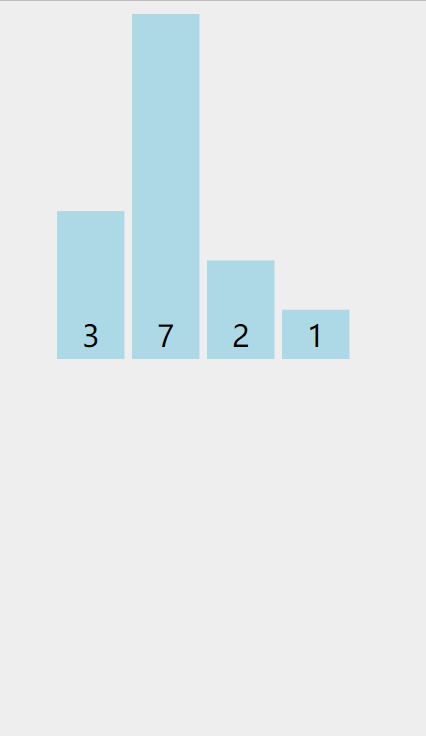我们在一些特定场景下,例如查询公司员工的最高薪资,以及班级的最高成绩又或者是面试中都会遇到查找最大值的问题,所以本文我们就来列举一下查询数组中最大值的 5 种方法。

首先我们来看最原始也是最“笨”的实现方法:循环对比和递归对比。
方式一:循环对比
循环对比的执行流程如下图所示:

从上图可以看出,循环对比的核心是定义一个最大值,然后循环对比每一个元素,如果元素的值大于最大值就将最大值更新为此元素的值,再进行下一次比较,直到循环结束我们就能找到最大值了,实现代码如下:
public class ArrayMaxTest {
public static void main(String[] args) {
int[] arr = {3, 7, 2, 1, -4};
int max = findMaxByFor(arr); // 查找最大值
System.out.println("最大值是:" + max);
}
/**
* 通过 for 循环查找最大值
* @param arr 待查询数组
* @return 最大值
*/
private static int findMaxByFor(int[] arr) {
int max = 0; // 最大值
for (int item : arr) {
if (item > max) { // 当前值大于最大值,赋值为最大值
max = item;
}
}
return max;
}
}以上程序的执行结果为:
最大值是:7
方式二:递归对比
递归对比的核心是先定义两个位置(起始位置和结束位置),每次对比开始位置和结束位置值的大小,当开始位置的值大于结束位置值时,将最大值设置为开始位置的值,然后将结束位置 -1(往前移动一位),继续递归调用;相反,当结束位置的值大于开始位置时,将最大值设置为结束位置的值,将开始位置 +1(往后移动一位),继续递归调用对比,直到递归结束就可以返回最大值了,执行流程如下图所示:

实现代码如下:
public class ArrayMax {
public static void main(String[] args) {
int[] arr = {3, 7, 2, 1, -4};
int max = findMaxByRecursive(arr, 0, arr.length - 1, 0); // 根据 Collections 查找最大值
System.out.println("最大值是:" + max);
}
/**
* 根据递归查询最大的值
* @param arr 待查询数组
* @param head 最前面的元素的下标
* @param last 最末尾的元素的下标
* @param max (临时)最大值
* @return 最大值
*/
private static int findMaxByRecursive(int[] arr, int head, int last, int max) {
if (head == last) {
// 递归完了,返回结果
return max;
} else {
if (arr[head] > arr[last]) {
max = arr[head]; // 赋最大值
// 从后往前移动递归
return findMaxByRecursive(arr, head, last - 1, max);
} else {
max = arr[last]; // 赋最大值
// 从前往后移动递归
return findMaxByRecursive(arr, head + 1, last, max);
}
}
}
}以上程序的执行结果为:
最大值是:7
方式三:依赖 Arrays.sort() 实现
根据 Arrays.sort 方法可以将数组从小到大进行排序,排序完成之后,取最后一位的值就是最大值了,实现代码如下:
import java.util.Arrays;
public class ArrayMax {
public static void main(String[] args) {
int[] arr = {3, 7, 2, 1, -4};
int max = findMaxBySort(arr); // 根据 Arrays.sort 查找最大值
System.out.println("最大值是:" + max);
}
/**
* 根据 Arrays.sort 查找最大值
* @param arr 待查询数组
* @return 最大值
*/
private static int findMaxBySort(int[] arr) {
Arrays.sort(arr);
return arr[arr.length - 1];
}
}
以上程序的执行结果为:
最大值是:7
方式四:根据 Arrays.stream() 实现
stream 是 JDK 8 新增的核心功能之一,使用它我们可以很方便的实现很多功能,比如查找最大值、最小值等,实现代码如下:
import java.util.Arrays;
public class ArrayMax {
public static void main(String[] args) {
int[] arr = {3, 7, 2, 1, -4};
int max = findMaxByStream(arr); // 根据 stream 查找最大值
System.out.println("最大值是:" + max);
}
/**
* 根据 stream 查找最大值
* @param arr 待查询数组
* @return 最大值
*/
private static int findMaxByStream(int[] arr) {
return Arrays.stream(arr).max().getAsInt();
}
}
以上程序的执行结果为:
最大值是:7
方式五:依赖 Collections.max() 实现
使用 Collections 集合工具类也可以查找最大值和最小值,但在使用之前我们想要将数组(Array)转换成集合(List),实现代码如下:
import org.apache.commons.lang3.ArrayUtils;
import java.util.Arrays;
import java.util.Collections;
public class ArrayMax {
public static void main(String[] args) {
int[] arr = {3, 7, 2, 1, -4};
int max = findMaxByCollections(arr); // 根据 Collections 查找最大值
System.out.println("最大值是:" + max);
}
/**
* 根据 Collections 查找最大值
* @param arr 待查询数组
* @return 最大值
*/
private static int findMaxByCollections(int[] arr) {
List<Integer> list = Arrays.asList(
org.apache.commons.lang3.ArrayUtils.toObject(arr));
return Collections.max(list);
}
}
以上程序的执行结果为:
最大值是:7
扩展知识:Arrays.sort 方法执行原理
为了搞明白 Arrays#sort 方法执行的原理,我们查看了源码发现 sort 方法的核心是通过循环进行排序的,源码如下:
for (int i = left, j = i; i < right; j = ++i) {
int ai = a[i + 1];
while (ai < a[j]) {
a[j + 1] = a[j];
if (j-- == left) {
break;
}
}
a[j + 1] = ai;
}执行流程如下图所示:

总结
本文介绍了 5 种查询数组中最大值的方法,从大的维度可分为:手动实现和依赖接口实现。手动实现主要是通过循环和递归对比的方式,但这种方式并不推荐,因为它不够优雅;依赖接口实现的方法有很多,其中主要推荐使用的是使用 stream 来实现查找最大值,因为它足够简单优雅。
关注下面二维码,订阅更多精彩内容。

作者: 王磊的博客
本文摘自 :https://blog.51cto.com/u

